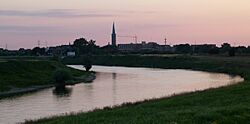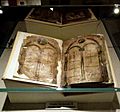Maaseik facts for kids
Quick facts for kids
Maaseik
Mezeik (Limburgish)
|
|||
|---|---|---|---|

Meuse river near Maaseik
|
|||
|
|||
| Country | Belgium | ||
| Community | Flemish Community | ||
| Region | Flemish Region | ||
| Province | Limburg | ||
| Arrondissement | Maaseik | ||
| Area | |||
| • Total | 76.91 km2 (29.70 sq mi) | ||
| Population
(2018-01-01)Lua error in Module:Wd at line 1575: attempt to index field 'wikibase' (a nil value).
|
|||
| • Total | Lua error in Module:Wd at line 1,575: attempt to index field 'wikibase' (a nil value). | ||
| Postal codes |
3680
|
||
| Area codes | 089 | ||
| Website | www.maaseik.be | ||
Maaseik is a city and town in the Limburg province of Belgium. It's located right on the Meuse river. Maaseik is one of the larger towns in Limburg, both in size and population. About 25,000 people live here.
Maaseik is also known as the possible birthplace of two very famous Flemish painters: Jan and Hubert van Eyck.
Contents
Exploring Maaseik's Geography
Where is Maaseik Located?
The town of Maaseik is on the left bank of the Meuse river. This river forms a border with the Netherlands here. That's why this part of the river is called Grensmaas, meaning "border Meuse".
Two smaller rivers, the Bosbeek and the Zanderbeek, also flow into the Meuse near Maaseik. The land around Maaseik is mostly fertile because it's in the Meuse valley. However, the northwestern part of the town has less fertile soil.
How the Meuse River Shaped Maaseik
The Meuse valley near Maaseik is about 4 kilometers wide. Maaseik itself is built on slightly higher ground. This has usually protected it from floods.
Over many centuries, the riverbed has moved east. It left behind old river paths and oxbow lakes. One old path of the Meuse can still be seen in Heppeneert, a small village south of Maaseik.
People have extracted gravel from this area for a long time. This created many old gravel pits. Most of these pits are now nature reserves or places for watersports.
Villages and Hamlets in Maaseik
The Maaseik area includes the main town of Maaseik. It also has the smaller towns of Neeroeteren and Opoeteren. Other small villages and hamlets are Aldeneik, Heppeneert, Wurfeld, and Dorne.
Maaseik's Rich History
Understanding Maaseik's Name and Beginnings
The name Aldeneik likely means 'old oak'. Maaseik means 'Meuse oak'. An oak tree is even on the town's coat of arms. This coat of arms also shows three crosses and a fish, which stands for the Meuse river.
Around 700 AD, a local lord named Adelard started Aldeneik Abbey. This was a Benedictine nunnery. His daughters, Herlindis and Relindis, became abbesses and later saints. The abbey helped a small village grow around it.
The abbey was probably destroyed by the Vikings in the 9th century. Later, in 950, it became a religious group for male canons. The abbey was left empty during the Eighty Years' War. But the canons moved to Nieuw-Eycke, which is now Maaseik.
Maaseik in the Middle Ages
The town of Maaseik was probably founded around the year 1000. It was near an old Roman road and safely located in the Meuse valley. The village grew and became an important trading center.
Maaseik officially became a city in 1244. In the 14th century, it became one of the 23 important cities of the Bishopric of Liège.
Maaseik was a planned town. Its four main streets started at the marketplace and led to four city gates. None of these gates still exist. The city walls were taken down in 1467 when Charles the Bold attacked the region.
From the 16th to 18th Century
Maaseik's economy was strong until the 16th century. This was thanks to trade and making cloth. Many people in the town were priests, monks, or nuns. Until the French Revolution, there were six monasteries in this small town.
In the 16th century, Maaseik was a center for a religious group called Anabaptism. The town almost broke away from Liège. But the prince-bishop managed to keep the town under control.
Louis XIV attacked Maaseik in 1672. The city walls, which had been rebuilt, were made stronger. The town suffered two big fires in 1650 and 1684. The 1684 fire destroyed one-third of the town. After that, building wooden houses was not allowed.
Maaseik in Modern Times
After the French left in 1814, Maaseik became part of the United Kingdom of the Netherlands. In 1831, it became a Belgian town.
The Industrial Revolution in the 19th century didn't affect Maaseik much. The town lost its importance and didn't grow a lot. This is why many houses from the 17th and 18th centuries still stand today.
The city walls were slowly taken down in the 19th and 20th centuries. Only a small part of the southern wall remains. Some street names, like Bospoort, remind us of the old city gates. In 2007, parts of a fortified tower were found during digging for a parking garage.
A railroad connected Maaseik to Hasselt in the 19th century. But it was removed around 1950 and is now part of a bicycle path. A bridge over the Meuse was built in the early 20th century. This bridge connected Maaseik directly with the Netherlands. It was destroyed several times during World Wars I and II. The current bridge was built in 1951.
Today, Maaseik is a local center for the towns around it. It has small factories, shops, restaurants, schools, and a hospital.
Discovering Maaseik's Places of Interest
Many buildings in Maaseik are protected as Beschermd erfgoed (National Heritage Sites). These include churches, monasteries, and many houses built in the local Mosan style. Twelve watermills around Maaseik have been restored. Some still work and can be visited.
Churches, Monasteries, and Historic Houses
The main church in Maaseik is the Sint-Catharinakerk (Church of Saint Catherine). It was built between 1840 and 1845. This church holds treasures from the chapter of Aldeneik. This group moved their treasures to Maaseik in 1571 for safety. You can see these treasures in the church's sacristy.
In Aldeneik, only the restored Sint-Annakerk (Church of Saint Anne) remains of the old abbey.
Several monasteries from the Baroque period are still in Maaseik. These include the monasteries of the Franciscans, the Capuchins, and the Holy Cross Canons. The Holy Cross church has a beautiful Rococo interior.
Maaseik has many protected houses, mostly in the Mosan Renaissance style. These houses are often built with brick, yellowish chalk, and blueish limestone. You can see many beautiful gables with original gable stones along Markt, Bosstraat, and Grote Kerkstraat.
The Lively Market Square
The main square in Maaseik is the Markt (Market Square). Here you'll find a 19th-century statue of the town's famous painters, Jan and Hubert van Eyck.
On the north side of the square is the 18th-century town hall. In front of it is a copy of the old perron. This was a symbol of freedom for the prince-bishopric of Liège.
Old houses surround the market square. Many have been turned into pubs and restaurants. In summer, outdoor terraces make the square a lively place.
Interesting Museums to Visit
- The church of Saint Catharine has an important church treasure. This includes the Codex Eyckensis, the oldest Gospel Book in the Benelux, from the early 8th century. The treasure also has ancient textiles, some believed to belong to local saints Herlindis and Relindis. You can also see old reliquaries and manuscripts.
- The Regionaal Archeologisch Museum (RAM) on Markt is a museum of local history and archeology. It also has a pharmacy museum. This pharmacy is thought to be the oldest in Belgium. It still has its original display of pots and jars. Behind the museum is a small herbal garden.
- The John Selbach Museum is in the nearby Franciscan monastery. It shows art and antique dolls. The building also has an exhibit about the Van Eyck brothers. There is also a scale model of the town as it looked in 1672. This building is also used for big exhibitions.
Famous People from Maaseik
- Saint Herlindis (died 745), an abbess and saint.
- Saint Relindis (died 750), sister of Herlindis, also an abbess and saint.
- Hubert van Eyck (around 1366 – 1426), a famous painter.
- Jan van Eyck (around 1385 – 1441), another famous painter.
- Johann Campanus (around 1500 - around 1575), a religious reformer.
- Patrick Damiaens (born 1966), a talented woodcarver.
Sports Stars from Maaseik
- Harry Everts (born 1952), 1975 motocross world champion.
- Vital Borkelmans (born 1963), a football player.
- Vital Heynen (born 1969), a volleyball player and coach.
- Sandra Stals (born 1975), an 800m athlete.
- Kristof Vliegen (born 1982), a tennis player.
- Max Verstappen (born 1997), a three-time Formula One drivers champion.
- Kristof Downer (born 1975), lived in Maaseik and played football for KMFC.
Maaseik's Twin Cities
Maaseik has friendly connections with these cities:
 Germany: Wegberg (Germany)
Germany: Wegberg (Germany) Netherlands: Echt-Susteren (Netherlands), located across the Meuse river.
Netherlands: Echt-Susteren (Netherlands), located across the Meuse river.
See also
 In Spanish: Maaseik para niños
In Spanish: Maaseik para niños

















